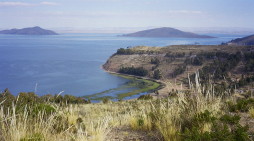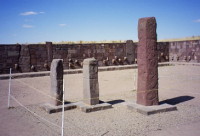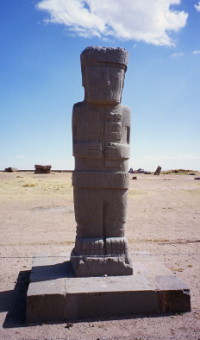 Photo.
Photo. Lake Titicaca in Bolivia. Which big
secrets are hiding below the surface? © Travel Explorations.
The AKAKOR team for the Tiwanaku 2004 expedition was joined by 22 people from
Italy (Lorenzo Epis, Emanuele Gaddi, Alessandro Anghileri, Stefano Castelli,
Paolo Costa e Giovanni Confente), Brazil (Soraya Ayub, Wilson Miranda, Guy
Collet, Otto Heitzmann, Mario Favareto, Jorge Maruo, Roberto Baracho, Sebastião
Simões, Roberto Tavarez, José Scaleante e Calina Scaleante) and Bolívia (Eduardo
Pareja, Wilson Perez, Ramiro Arispes, Javier Salas e Renan Ramirez).
The team has been working in Bolivia for 10 years and carried out expeditions
searching for traces from ancient time. In 2000 they found structures and man
made artefacts at 0 to 30 meters depth. It's believed to be from the Tiwanakotas
civilization.
Photos. Tiahuanaco (also called Tiwanaku) near La
Paz in Bolivia. © Travel Explorations.
|
Tiahuanaco is believed to has been a major ceremonial centre of a
culture that spread across much of the region. The ancient people built a
pyramid of crude stones known as the Akapana.

|

|
The AKAKOR team returned in 2004 with necessary technology to work at 50 to
150 meters deep. They got support and help from governments, other
organisations, Bolivian Navy and indigenous people who live in the area.
This time the team discovered roads and containing walls dated
back to 6,000 years ago at 120 meters depth. A particularly interesting discovery
was the find of a gold statue (35 kilos in weight). According to the official
historical version, the birthplace of the civilization precursor to the Incas
would be the Isle of the Sun. The "Isla Del Sole" was not an island at the time
and, thanks to bathometrical measurements, the link to the land has been found
at a depth of 75 meters. Everything has been methodically mapped out and now the
team search for finding the real Isle of the Sun, which would be under
water.
Probably the team's most amazing find was cave. During centuries locals have
told stories about an old cave where humans become sacrificed. It's believed
that 200 children become sacrificed in one day. Nobody knew where this was and
some doubted the cave's existence. This cave was found together with the remains
of little children.
The AKAKOR team has achieved approvement for their work. CNN has followed the
team for a documentary. At Tiwanaku, on the occasion of the opening of a dig at
the pyramid of Akapana, the AKAKOR team was received by the Bolivian President
Dr. Carlos Mesa.
The gathered material will be processed and analysed by
the AKAKOR expedition team. They will also extend their search for new finds
in a wider area below the surface of Lake Titicaca. So far their research has been
restricted to 20 square kilometres out of the possible 8,000, according to the
expedition team. There is no doubt that these finds will bring new light to
the history of an ancient civilisation in South America.
Stein Morten Lund, 27 October 2005
Additional information
Links for more information about the AKAKOR team
work and finds:
http://www.akakor.com/english/tiwabrief-uk.html
http://www.akakor.com/english/tiwasped-uk.html
Read also articles on our website Travel Explorations based on my tour
in Bolivia in July 2002. One of the highlights on the tour was exploring the
ancient site of Tiahuanaco.
Tiahuanaco (also called Tiwanaku) was
obvious a major ceremonial centre of a culture that spread across much of the
region. The ancient people built a pyramid of crude stones known as the Akapana.
